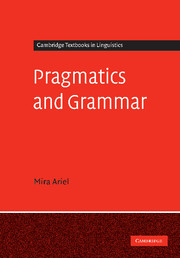Book contents
- Frontmatter
- Contents
- List of tables
- Preface
- Acknowledgments
- How to use this book
- Transcription conventions
- 1 Introduction: Grammar, pragmatics, and what's between them
- PART I Drawing the grammar/pragmatics divide
- PART II Crossing the extralinguistic/linguistic divide
- Part III Bringing grammar and pragmatics back together
- 7 Grammar/pragmatics interfaces
- References
- Author index
- Subject index
7 - Grammar/pragmatics interfaces
Published online by Cambridge University Press: 05 September 2012
- Frontmatter
- Contents
- List of tables
- Preface
- Acknowledgments
- How to use this book
- Transcription conventions
- 1 Introduction: Grammar, pragmatics, and what's between them
- PART I Drawing the grammar/pragmatics divide
- PART II Crossing the extralinguistic/linguistic divide
- Part III Bringing grammar and pragmatics back together
- 7 Grammar/pragmatics interfaces
- References
- Author index
- Subject index
Summary
Our main goal in chapter 7 is to present various concepts of the semantic/pragmatic interface level of ‘what is said.’ We first introduce the problems in defining such a basic-level meaning representation (section 7.1), and then discuss four proposals as to how to define the concept (sections 7.2–7.6). We reiterate the main conclusions of the book in section 7.7, briefly considering the possibility that ‘what is said’ is not only important for grammar/pragmatics interfaces during interaction, but also in processes in which pragmatics crosses over to become grammar.
The widening gap between ‘what is said’ and a basic-level meaning
Ideally, as a basic meaning level, ‘what is said’ should stand for (i) a complete truth-evaluable proposition, the speaker's basic intended meaning, which is, moreover, (ii) expressed explicitly. Conventional implicatures, although conventional, do not constitute part of ‘what is said,’ because they are neither explicit nor truth-conditional (but see section 7.5 below). Even Grice, however, realized that as rudimentary as his ‘what is said’ was, it could not be equated with pure linguistic meaning. This is why he proposed that ‘what is said’ is “closely related to the conventional meaning of the words (the sentence)” (Grice, 1989: 25, emphasis added).
- Type
- Chapter
- Information
- Pragmatics and Grammar , pp. 261 - 308Publisher: Cambridge University PressPrint publication year: 2008



